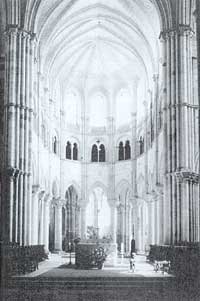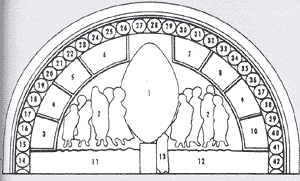Basilique Sainte Madeleine
Dr. Marie-France Hilgar
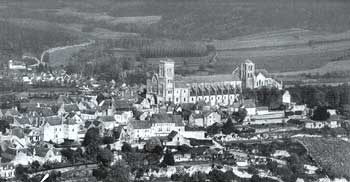
It was at the foot of the hill of Vézelay that Girart de Roussillon first established a nunnery around the year 860. Destroyed by Norman invaders, this establishment was soon entrusted to Benedictine monks from Autun and moved up onto the nearby hill which is now Vézelay. Girart placed the monastery under the sole authority of the Pope and dedicated it to Saints Peter, Paul, and Mary.
History would no doubt have been little concerned with this monastery if the arrival of the relics of Mary Magdalene, brought from St. Maximin at the beginning of the eleventh century had not given rise to a cult of this saint. Thousands of pilgrims took to the roads, heading for the holy hill to venerate the one who had so pleased Christ that she was the first to see him return from the dead. She is above all the apostle of the Apostles, the first witness of the resurrection. St. Odon of Cluny defined the position of Mary Magdalene in the over-all pattern of God as follows:
The Virgin Mary is rightly called the Star of the Sea. This symbol is particularly appropriate to the Mother of God, for by the virgin birth the sun of justice rose over the world. But it could just as appropriately be applied to Mary Magdalene who, corning to the sepulcher bearing incense, was the first to announce to the world the Splendor of the Resurrection.
The extraordinary activity resulting from the influx of pilgrims brought Vézelay rapidly to the foreground in the Christian world. The Monastery became one of the four points of departure for pilgrimages to Compostella, grouping pilgrims from the north and east. The prestige of the Monastery involved the Abbots in serious difficulties caused by the jealousy of their neighbors, the Bishops of Autun and the Counts of Nevers, and the discontent of their own parishioners; fires, raids, the murder of an Abbot, desecration of relics; in short, the Benedictines did not live peaceful lives.
Nevertheless the Basilica continued to be embellished and remains today a witness to its glorious past. For its real glory cannot be overshadowed; meeting place of saints, kings, heroes, as well as the multitude of common man. St. Bernard preached the Second Crusade on the hill's northern slope. St. Thomas Beckett, future martyr, prayed under the church's vault. Philippe Auguste and Richard the Lion Hearted assembled their armies here before leaving for the Holy Land. Brother Pacifique and his companions sent by St. Francis found the atmosphere of the region reminiscent of Assisi and established their first monastery in the kingdom of France. And St. Louis, three years before his death as a crusader, came for the last time to render homage to Mary Magdalene.
The decline of the Monastery began in the mid-13th century, shortly before rumors spread of new relics in St. Maximin (1279). Pillaged and desecrated during the Wars of Religion in the 16th century, it was given to an absentee Abbot and finally in the 17th century incorporated in the diocese of Autun. The Revolution almost dealt it a final blow. Sold in 1796 as national property, the monastery was completely torn down. Only the basilica survived, a long, rather squat, gray building marked by innumerable modifications and repairs. Viollet-le Duc's restoration in the mid-19th century saved it from complete ruin which lack of care made inevitable, and the architecture of the primitive structure re-appeared. The original beauty of the church has been preserved in all its perfection: an architecture which in a sacramental way reveals a terrestrial and temporal place enclosing heaven and the eternal realities, enabling us to see something of heaven on earth.
THE EXTERIOR
From whatever road the Magdalene is approached, the view is remarkable and so integrated with the site that it seems God and Man worked together to obtain perfection. It is difficult, however, to imagine what the original facade looked like in 1150, modified as it is by the addition of a Gothic pediment in 1250 and by the upper story of the St. Michael tower. Time and man have added to its sufferings: rain, frost and fire, followed by revolutionary destruction. At ground level, the well-proportioned doorways have been entirely rebuilt. The central tympanum represents a subject frequently used in the Middle Ages, the Last Judgment. It is set on a lintel depicting episodes in the life of Mary Magdalene, the resurrection of her brother Lazarus, and the supper with Simon the Pharisee. The capital of the portal column depicts Christ blessing, surrounded by the symbols of the four Evangelists. The Gothic window over the main door is ornamented with statuary. Below, from left to right, St. John the Evangelist, St. Andrew, St. John the Baptist, St. Peter, St. Paul, and probably St. Benedict. Above, two angels flank the Virgin and St. Mary Magdalene standing to the right and left of Christ. In the minds of Mediaeval man, these two places of honor belonged quite naturally to the two Marys, each in her way a symbol of the Church. Seen from the terrace, the apse of the Basilica with its five radiating chapels forms a sort of crown whose harmonious, rounded lines contrast happily with the severity of the walls of the nave.
The plan of the church is very simple. It is in the form of a Latin cross, composed of a narthex, nave, sanctuary and apse. The total length is about 400 feet. The cross arms or transepts are very short, barely projecting beyond the exterior walls. The gable of the south transept with three lancet windows is visible beyond the massive outlines of the St. Anthony tower. The progress of the construction chronologically can be seen clearly.
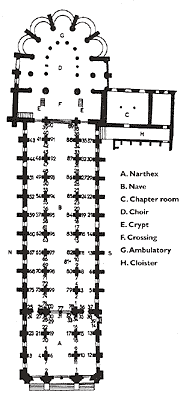 |
1) The nave, constructed after a fire in 1120, which destroyed the Carolingian nave. It is composed often bays with side-aisles two-thirds the height of the central aisle, thus leaving room for clerestory windows to light it. The flying buttresses were added in the Gothic period and completely rebuilt by Viollet-le-Duc. This remarkable structure is one of the finest examples of pure Burgundian Romanesque Architecture.
2) The narthex, started when the nave was finished, around 1140.
3) Finally, no doubt due to lack of space in the earlier construction, the Romanesque transepts and sanctuary were replaced in 1185 by an Early Gothic structure. By 1215, the building was complete.
Before entering the church one can observe the following:
One side of the cloister, at the base of the St. Anthony tower, was constructed by Viollet-le-Duc to protect the Chapter Room. It gives an idea of what the completed monastic cloister might have looked like. Above the Chapter Room is a large room no doubt originally the monks' dormitory and now an Architectural Museum where sculptures removed from the church, plaster casts, and prints permit a study of the merits or demerits of the 19th century restoration. The original tympanum from the main facade, disfigured by hammer and chisel during the Revolution, has been placed against the wall of the eighth bay. In the light of the setting sun the subject matter of the sculpture is faintly visible.
THE INTERIOR
|
The Sanctuary |
Upon entering the semi-obscurity of the narthex of the Magdalene a remarkable view presents itself.
Beyond the doors of the inside portal where Christ cries out from the great tympanum "I am the Way," stretches a wide avenue of light, modulated by the calm strength of the nave arcade, leading to the dazzling illumination of the sanctuary, the goal of a liturgical movement where man may meet God. The modern mind tends to be struck by the contrasts between the narthex, the nave and the sanctuary. In fact, these different elements in different styles of architecture have an astonishing unity. A very special significance was instilled in the construction of this building. Used both as a monastic church and a pilgrimage place, the faithful pass from the obscurity of the west to the light of the rising sun, symbol of Christ's definitive triumph over death.
The narthex, a large vestibule, is by its proportions a veritable church. It was used for liturgical purposes in addition to others such as a shelter for pilgrims on overcrowded nights, a church for the preparation of converts for baptism, a church for penitents momentarily forbidden access to the main church. It was undoubtedly used for ceremonies preliminary to baptism, for exorcism, for the pardoning of penitents, but these uses alone do not justify the construction of such a monumental vestibule to a main church. 12th-century documents call the narthex of monastic churches "Galilee." Important ceremonies began with great processions symbolizing the Apostles going to Galilee to see the risen Christ. A ceremony of purification preceded the principal service and this took place in "Galilee." Commentators of Christ's words to Mary Magdalene, "I will precede you in Galilee" explain that Galilee is the place of passing over, as the Redeemer, passing from the crucifixion to the resurrection, passed over from death to life. Monks, pilgrims, the faithful, following in the footsteps of the Apostles, will see with joy the glory of the resurrection if they pass over also from the shadows to the light, that is if they believe in Christ, the light of the world. Thus the Galilee of the Magdalene becomes that privileged place to pass from the profane to the sacred, the place to find physical and spiritual order, the place to remove the weight of the world, weariness, worries, pain, anguish and sin, preparatory to receiving the purification which comes down from heaven. Then the believer will be ready to cross the second threshold of the Magdalene, which gives access at last to the kingdom of light, the realm of the serene and luminous Church.
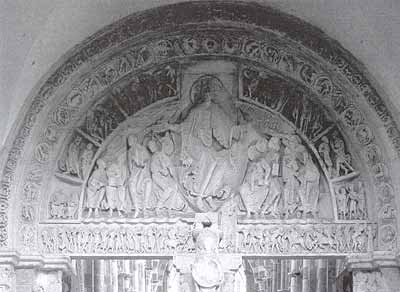
The description of Pentecost is illustrated on the interior tympanum with its various protagonists and events assembled together. This sculpture, done between 1120 and 1130, is one of the most beautiful examples of Romanesque times. (See diagram).
|
THE TYMPANUM SCULPTURE 1. Christ. |
1) Christ is seated in the center in a mandorla, symbol of the glory of His resurrection, with the majesty of a King and Priest due to His great stature, the gesture of His arms thrown wide open, His voluminous pleated robes and His serene expression. The flames of the Holy Ghost shoot down from His large hands to the Apostles.
2) The Apostles, in groups of three, surround Christ, some still seated, others half rising ready to depart to the four corners of the earth. On the left, identifiable by his keys, is St. Peter, the first of the twelve apostles, his halo overlapping the mandorla. All are holding the Gospel, which it is their mission to carry to all men. Above them, to the right and left of Christ, are the leaves of the Tree of Life, which will convert unbelievers, and the water of life, which springs from the throne of God (Apoc. 22:1-2).
3) to 10) The Converted Races: the interpretation of each scene is difficult, but the whole represents the preaching of the Apostles to the various races, and the miracles confirming this preaching, especially miracles of healing. Some of the figures are engaged in animated discourse. Others seem to be showing healed bodies.
11) and 12) The Pagan Races: on the left, a procession in a pagan sacrificial ceremony? (Jews? Romans?) On the right, legendary races: giants, pygmies, elephant-eared Panotii. A band of water separates the pagans from Christ and the Apostles. Their position in God's world plan is clearly shown by the Apostles Peter and Paul 13) going down to them from the realm of the Spirit to lead them up through the waters of baptism.
14) to 42)The Signs of the Zodiac and Corresponding Monthly Activities: Christ eternal, King of the Universe, is also King of Eternity, Master of space and time. This is the significance of the arch composed of medallions where the Signs of the Zodiac alternate with scenes of corresponding calendar activities. At the top, between Cancer and Leo, a dog, an acrobat, and a siren are turning somersaults.
The beauty of the tympanum derives from the grandeur and optimism of the spiritual theme illustrated. The Church gathers together all creation into the Kingdom of God. The symbolism used is reasonably clear. The various groups are arranged to move around the central figure of Christ, the pivot of the world. The varying sizes of the figures, from an immense Christ to the diminutive pagans, correspond to each one's degree of holiness. The huge right hand of Christ bears witness to His strength. Natural elements such as water, foliage, and wind represent God-sent salvation and the Holy Ghost who fortified the Apostles. Noteworthy also are the wide variety of poses employed, the majestic attitude of Christ, the animation of the Apostles, the gesticulations of the pagans, the skilled use of pleated drapery to delineate the figures. Some of the Apostles are represented again on the door-jambs, suggesting that they have already left the events illustrated in the tympanum to start on their evangelical journey. On the central column at the feet of Christ, John the Baptist displays the Lamb of God.
Balance, rhythm, and luminosity: these three words sum up the impression conveyed by the nave.
Balanced proportions: 40 feet wide, 60 feet high, and 200 feet long, the structure is on a human scale, and the stability of its horizontal lines forms a harmonious prelude to the soaring verticality of the sanctuary. Rhythm: it is obtained not only by the processional repetition of the bays, but by decorative motifs which discretely emphasize the main lines of the structure. Luminosity: the soft tones of the stones, tinted by time and nature, ranging from ash-gray to light gold, varied by rose and green, enlivened by the contrasts of dark and light in the main arches, form a delicate prelude to the uncompromising white of the sanctuary. But the color of the stones, even when combined with the number, location, and dimensions of the windows, is insufficient to explain the quality of the light. Recent studies prove that the orientation of the church has taken into account the movement of the earth around the sun so that on the summer solstice, more exactly on the 24th of June, feast day of St. John the Baptist, at noon by sun time the sunlight from the clerestory windows falls on the floor of the main aisle exactly in the middle of each bay, like so many road markers leading the way to the sanctuary. In this manner, incorporated in the actual structure of the church on the way from the narthex to the sanctuary is found the message of the passage from the shadows of death to the rising sun, Christ the Light of the World, a message brought to mankind by the precursor, John the Baptist.
The Sanctuary. Proceeding from bay to bay, the end of the road is reached. The sanctuary is the most hallowed part of the structure. It is a Gothic sanctuary, identifiable by its rib vaulting, large windows, and the importance given to purely decorative elements. It is easy to identify the various structural elements making up the architectural composition. Columns surrounding the raised sanctuary support groups of smaller columns, which in turn support the vault's ribs. Between the groups of smaller columns paired arched openings give onto the triforium gallery, and higher up between the vaults, large windows shed a bright light on the white stone. Again an impression of rhythm emerges, but this time with an ascensional rather than a processional connotation. Attention is now drawn up to heaven.
The original plan seems to have called for 8 monolithic columns. However, a smaller column was incorporated on the south side, and a pair of smaller columns on the north. These 11 columns suggest the Last Supper celebrated by the Apostles with Christ after the departure of Judas. In the triforium gallery, where Christ is represented by a cross, in the middle, there are 12 columns, 11 round and 1 square, symbol of imperfection and representing Judas present with his brother Apostles. Moreover, each of the 8 columns support 3 smaller columns for a total of 24, reminiscent of the 24 elders in Revelations who surrounded the throne of Christ and worshipped Him. Finally, 144 small columns are found in the chapels of the ambulatory, suggesting the multitude of saints (12 times the 12 tribes of Israel).
The sanctuary is surrounded by an ambulatory from which radiate well-proportioned chapels. Traces of very old frescos can be seen on the columns, one of which represents the martyrdom of a person with long hair.
In the south transept can be seen a recent statue of Mary Magdalene, near an altar, possibly Carolingian, surmounted by a 16th-century reredos dedicated to St. Hubert. A rectangular opening permitted sacred objects to come in contact with relics, perhaps those of Mary Magdalene.
The north transept contains a statue of St. Francis of Assisi. Brother Pacifique, one of the first Franciscans, came to Vézelay and founded the still existing hermitage of Cordelle. There is also a modern statue of St. Bernard who preached the Second Crusade in Vézelay in 1146. A later Crusade took place in 1946 when pilgrims coming from all over Europe brought heavy wooden crosses to represent the sufferings of the wars and to pledge their faith in the Resurrection. These crosses can now be seen along the walls of the side aisles.
The access to the crypt is by stairs located in both transepts. This is the oldest part of the church. The niche behind the grille where the reliquary of Mary Magdalene is placed is a ninth-century structure. A 16th- or 17th-century wooden crucifix hangs over a modern altar. In its simplicity, quietness, and subdued light, the crypt forms a foundation of remarkable force for a church flooded with light. The life of penitence of Mary Magdalene earned her eternal joy. Through the ages her relics have attested to her spiritual presence in this site, which has drawn multitudes in search of forgiveness.
The capitals in the Magdalene: Both narrative subject matter and purely decorative motifs are used on the capitals of the church. Different groups of sculptors worked on the capitals over a reasonably long period of time. The decorative capitals are inspired by the oriental bestiary: lions, elephants, pelicans, or fanciful beasts such as three-headed birds, dragons, basilisks. A wide variety of exotic and local foliage appears on practically all the capitals, serving as a background, sometimes symbolically, to the episodes of the storied capitals. The storied capitals derive their subject matter largely from the Old and New Testaments and from the Lives of the Saints. Occasionally the theme represents a moral lesson such as the punishment of sin, an allegory, or a subject from Greco-Latin mythology. The story is generally illustrated on the three faces of the capital, reading from left to right.
There are ninety-nine capitals in the nave alone. The following descriptions will be limited to those capitals for which we have fairly "legible" pictures.
First, the Mystic Mill (no. 15 on the plan): It is the church's most beautiful symbolic capital. A man dressed in a short garment and boots pours grain into a mill while another man with a big forehead, bare-footed and dressed in a flowing garment, gathers the flour. The first individual represents Moses. The grain is the Old Testament Law received on Mt. Sinai. The mill is Christ, Who grinds the grain, and the Apostle Paul gathers the flour, representing the teachings of the New Testament. The Law of Moses contained the truth, but it was difficult to understand, hidden like the flour in the grain. By the sacrifice of Christ on the Cross, it was transformed into the Law of the New Testament which it was St. Paul's mission to gather and distribute. The depth of the theological material and the artistic quality of this capital suggest that it may be the work of the creator of the main tympanum of the narthex.
St. Benedict revives a child 22). On the left, a monk. In the center, Benedict, identified by his robe, tonsure and book, blesses the body of a child wrapped in a shroud beneath a palm tree. The peasant father looks on sadly, leaning on a tool. On the right, not visible on the picture, he joyfully carries away his revived child.
Death of a Rich and a Poor Man 16). On the left, the pauper Lazarus, crouching on the rich man's doorstep, gives up his soul, which is carried to heaven by angels in an aureole. In the center, attended by women mourners, the rich man dies in his bed, under which a serpent is entwined on his moneybags, while two demons wrench out his soul with pincers. (Lk. 16).
Isaac blesses Jacob 27). In the center, with his hands covered by animal hide to imitate the hairy body of his elder brother Esau, Jacob receives the blessing of the first born from his blind father Isaac. By this subterfuge he becomes the leader of the tribe which, 16 centuries later, gives birth to Christ. On the left, Esau returns from the hunt. On the right, not visible on the picture, Rebecca observes the success of the trick she invented. (Gen. 27).
Moses and the Golden Calf 54). When Moses came down from Mount Sinai where God had given him the Ten Commandments, he found his people worshipping the Golden Calf, a derivative of the Bull Apis in the Egyptian religion. On the left, Moses raises a staff to strike the Calf and brandishes the Tablets of the Law. A devil flies out of the Calf's mouth. (Ex. 32).
Abel's and Cain's Sacrifices 95). On the left, Abel offers up a lamb to God whose hand comes out of a cloud to bless him. On the right, Cain, who is jealous, offers a sheaf of wheat with bowed head and one hand on his hip. (Gen. 4).
Adam and Eve 96). The trunk of the tree and the serpent's body are entwined in a remarkable manner. (Gen. 3).
To understand the 12th-century mentality and its Romanesque symbolism, St. Augustine is of great assistance. For him, visible beauty opens the door to invisible reality represented and revealed by a reflection which beauty mysteriously possesses. "The stone construction where the Church assembles its children to praise God is the wordly prefiguration of the Eternal Temple of heavenly Jerusalem." This statement is the key to the mystery of the Magdalene.
In order to participate in the esthetic and religious reactions of Romanesque man, both mind and heart must be involved. Then, architectural beauty becomes a source of liberation and delight for the body, of joy and solace for the heart.
Dr. Marie-France Hilgar is a native of France, mother of four children, and assists at the Latin Mass at Our Lady of Victory Church, Las Vegas, NV. She was Distinguished Professor of French at the University of Nevada, Las Vegas and International President of the Foreign Language Honor Society. She specializes in 17th-century history and has authored several books and more than 100 articles.
